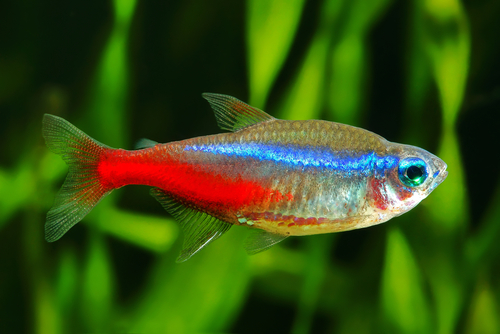Neon Tetras are some of the most popular aquarium fish in the world, and for good reason. They’re striking to look at, they’re small and sweet, and they’re pretty easy to take care of. On top of all of that, they are calm and relaxed fish as well, but you still need to be careful about which fish you keep with them.
We’re going to explain what the best neon tetra tank mates, so you can have a diverse community of your own that’s both happy and healthy.
Contents
What You Need To Know – Neon Tetra Tank Mates
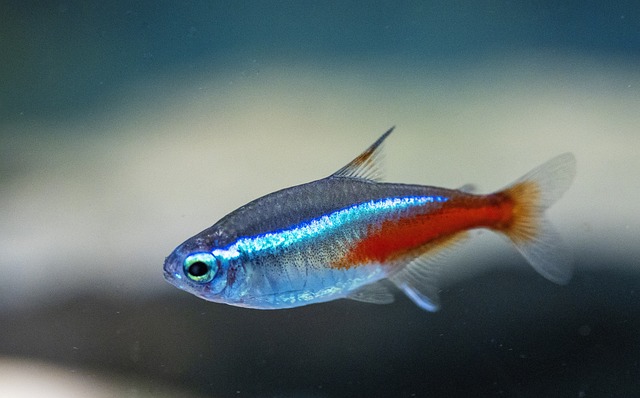
It is important that you are aware of quite a few things when you’re looking for tank mates to live alongside your Tetras, otherwise, you can end up with fights, competition, or even worse.
Competition
When you’re housing multiple animals in the same space, no matter what kind of creatures they might be, they are all going to have their own needs.
If you are not able to provide enough space and resources for every individual that is living together, they will end up competing. Some of the fish can then lose out on vital food or room to move.
Size
The size of your Neon Tetras’ tank mates is also very important. If they are too large, fish are likely to view your Tetras as prey, or just dominate the space and leave them feeling anxious and stressed.
Most of the fish that we are going to recommend on this list are pretty small in size, though there are a few exceptions that are very docile and relaxed.
Temperaments
When you’re selecting tank mates to live together, you have to ensure that they have compatible temperaments. Neon Tetras are small and non-aggressive, so they don’t do well around more assertive or threatening species.
What you want are peaceful, calm fish that will get along together without causing any conflict.
Parameters ; Tank Setup
Perhaps the most important consideration when you’re looking for new friends to live alongside your Neon Tetras is making sure that all the individual fish are going to be comfortable with conditions that are the same. The water parameters and tank setup that is healthy for one species can be harmful or even deadly to another.
Fortunately, Neon Tetras are quite hardy and tolerate many different conditions. In terms of the parameters they need for their water, you should look to have:
- Temperature: 70°F-81°F
- pH Level: 6-8
- Hardness: 2-10 dGH
When it comes to the size of the tank, things are a little more complicated. 10-gallons is the absolute minimum size of tank you would require for housing Neon Tetras. That space is enough for around 6 fish, which is the smallest group size that they are comfortable living in.
If you are going to add tank mates to the equation, though, you are going to need more space, and each fish can need a different amount of room to move around in.
Neon Tetra Tank Mates
So, now that we know a little bit about what makes a good tank mate for a Neon Tetra, we can start exploring some of the most popular options out there for you to choose from.
We have got a list of the top 15 species that will be more than happy to live with your Tetras, along with some details about each one so you can decide who you might want to consider moving in.
Other popular posts you don’t want to miss out:
1. Dwarf Gourami
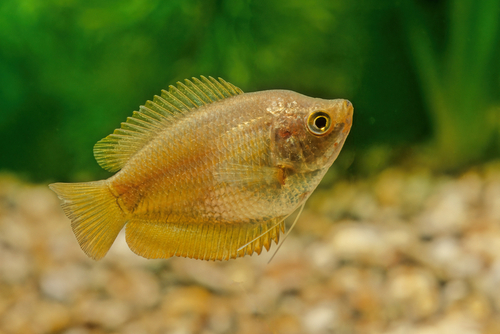
- Scientific Name: Trichogaster lalius
- Size: 3.5 – 4.5 in
- Water Temperature: 75°F – 80°F
- Minimum Tank Size: 10-gallon – 3 fish
- Care: Easy
- Compatible Species: Mollies, Platies, Swordtails, Zebra Loaches
- Origins: Pakistan, India and Bangladesh
If you’re looking for something with variety and beauty, then you can’t go wrong with a classic Dwarf Gourami. These little guys are very peaceful and low-maintenance, so they are a great option for beginners.
They are actually quite interesting to care for as well, because they will hunt down their prey. If you want to try out feeding with live food, Dwarf Gouramis can spray water from the surface to knock insects out of the air.
Pros
- Easy to breed
- Hardy
- Variety in terms of color
Cons
- Sensitive to loud noises
- Take time to adapt to new environments
2. Zebra Danio
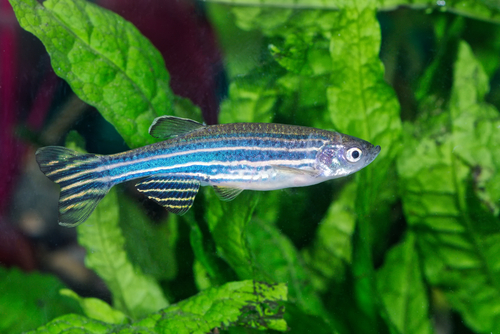
- Scientific Name: Danio rerio
- Size: 1.5 – 2.5 in
- Water Temperature: 64°F – 77°F
- MinimumTank Size: 10-gallon – 5 fish
- Care: Easy
- Compatible Species: Corydoras Catfish, Platies, Kuhli Loach, Swordtails
- Origins: India, Bhutan, and Bangladesh
You will find a number of kinds of Danio out there that are popular additions to any aquarium, but the Zebra Danio is perhaps the best fit for a Neon Tetra tank. They are easy to identify because of the distinct zebra-like striped pattern down their sides which gives them their name.
These little fish are peaceful and are friendly with most other small species, and they look great too!
Pros
- Interesting appearance
- Lively and entertaining
- Easy to look after
Cons
- Prefer a longer tank
- Not best-suited to a tank with long-finned or slow-moving fish
3. Swordtail
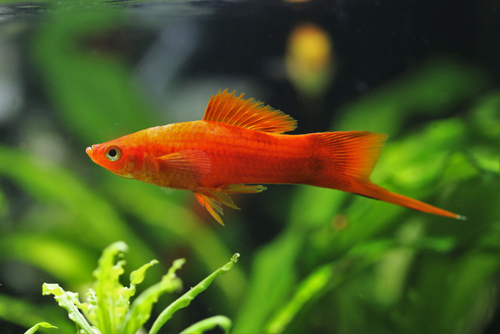
- Scientific Name: Xiphophorous helleri
- Size: 5.0 – 6.4 in
- Water Temperature: 70°F – 82°F
- Minimum Tank Size: 15-gallon – 1 individual
- Care: Easy
- Compatible Species: Platies, Mollies, Kuhli loaches, Angelfish
- Origins: Central and North America
It should come as no surprise that these distinctive little fish have long, sharp tails that look like swords. Swordtails are attractive, colorful, and have been bred to come in a variety of color morphs.
While they are very easy-going in most circumstances, it is best to have two females for every male otherwise the males can become territorial and aggressive.
Pros
- Colorful and varied appearance
- Active swimmers
- Lively personalities
Cons
- Vulnerable to fin-nipping species
- Males can become aggressive if there are not enough females
4. Guppy (genus)
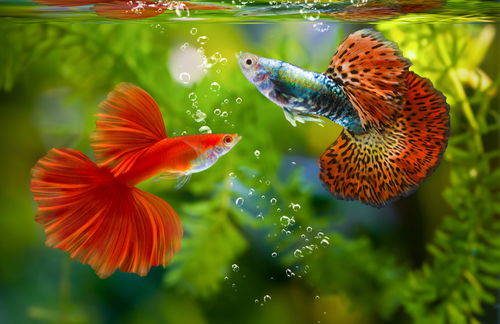
- Scientific Name: Poecilia reticulata
- Size: 0.5 – 2.5 in
- Water Temperature: 72°F – 84°F
- Minimum Tank Size: 4-gallon – 3 fish
- Care: Easy
- Compatible Species: Mollies, Platies, Corydoras Catfish, Swordtails
- Origins: South America
If you know anything about the aquarium hobby, then you will surely have heard of Guppies. These fish are low-cost and low-maintenance, but incredibly beautiful to look at, which is why they have become a staple in tanks around the world.
There are many different Guppies to choose from, but they are all pretty hardy and easy to care for.
Pros
- Great for beginners
- Variety of colors and patterns
- Males like to show off their fins and colors
Cons
- Vulnerable to large or aggressive fish
- Can become unhappy if the school is too small
5. Harlequin Rasbora
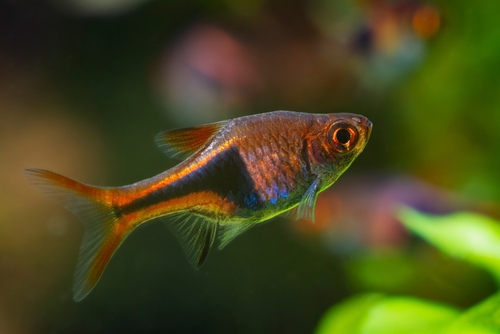
- Scientific Name: Trigonostigma heteromorpha
- Size: 0.5 – 0.9 in
- Water Temperature: 72°F – 82°F
- Minimum Tank Size: 10-gallon – 6 fish
- Care: Intermediate
- Compatible Species: Cardinal Tetras, Corydoras Catfish, Plecos, Mollies
- Origins: Malaysia, Singapore, Sumatra and southern Thailand
Tiny and adorable, Harlequin Rasboras is about the most popular type of Rasbora for aquariums because of their fun behavior and bright colors. They are typically orange or pink with a dark triangular marking on the back half of their bodies.
They do like to live in relatively large schools and are very entertaining to watch interacting with each other and swimming around the tank. They spend most of their time at mid-level but fo like to hide in plants and crevices as well.
Pros
- Small and vibrant
- Exciting schooling behavior
- Peaceful
Cons
- Are happiest in groups of 8 or 10
- Vulnerable to larger fish
6. Molly (genus)
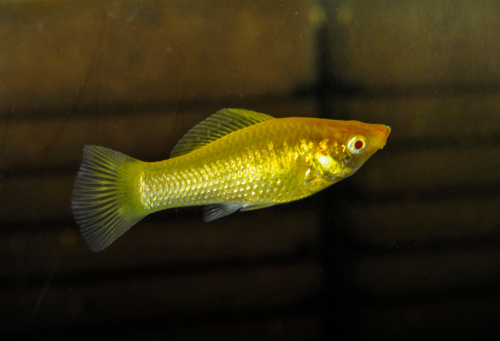
- Scientific Name: Poecilia genus
- Size: 3.5-4.5 in
- Water Temperature: 70°F – 82°F
- Minimum Tank Size: 10-gallon – 3 fish
- Care: Easy
- Compatible Species: Danios, Tetras, Loaches, Barbs, Corydoras Catfish
- Origins: Southern United States down into Central America
Molly Fish are another group that come in a number of different types, including the Sailfin Molly, Dalmatian Molly, Lyretail Molly, and Black Molly. They can also be found in several different colors like white, silver, red, black, purple, and orange.
These fish are rarely aggressive, but there are some things that can get them riled up. If the tank is too crowded or their group size is too small, you may seem some distress and angst.
Pros
- Variety of colors
- East to care for
- Low-cost
Cons
- Can become aggressive in a crowded tank
- Require a group of 4 minimum
7. Cherry Barb
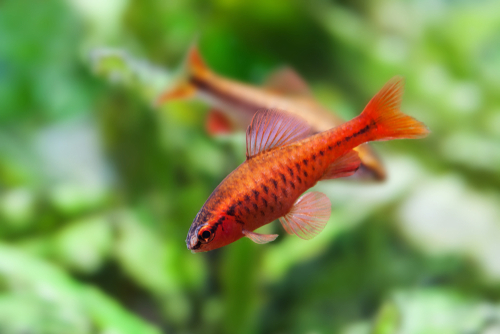
- Scientific Name: Puntius titteya
- Size: 1.5 – 2 in
- Compatible Species: Otocinclus Catfish, Pearl Gourami, Kuhli Loach, Mollies
- Water Temperature: 73°F – 81°F
- Minimum tank size: 10-gallon – 5 fish
- Care: Easy
- Origins: Sri Lanka
Of the Barb genus, Cherry Barbs are perhaps the most vibrant and best-suited to life alongside your Neon Tetras. These fish are a strong red color with a distinctive dark stripe down their sides.
Cherry Barbs are friendly when housed with the most calm fish species but, at times, they can act a bit timid and skittish, so they like to have a lot of places to hide inside the tank.
Pros
- Bright colors
- Tolerant and hardy
- Exciting schooling behavior
Cons
- Prefer abundant vegetation
- Vulnerable to large, aggressive fish
8. Platy (genus)
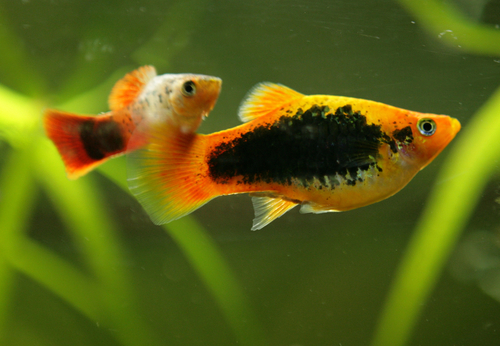
- Scientific Name: Xiphophorus genus
- Size: 2 – 3 in
- Water Temperature: 70°F – 77°F
- Minimum Tank Size: 10-gallon – 5/6 fish
- Care: Easy
- Compatible Species: Tetras, Snails, Corydoras Catfish, Rasboras, Bristlenose Plecos
- Origins: Central and South America
Yet another genus for our list that is varied and interesting, but easy-going and likely to be happy alongside most peaceful tank mates, are the Platy Fish. Among the most common types that you will find are the Comet Platy, Gold Red Platy, Pintail Platy, and Rainbow Platy.
They are social fish that are most confident in a group of around six fish, and they love exploring and finding little places in the tank where they can hide.
Pros
- Variety of colors and fin/tail shapes
- Hardy and tolerant
- Peaceful
Cons
- Males can pester females and be aggressive toward other males
- Prefer dense vegetation
9. Cardinal Tetra
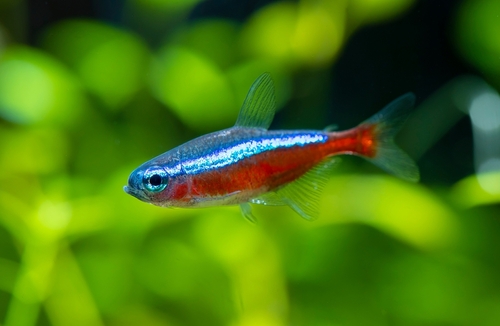
- Scientific Name: Paracheirodon axelrodi
- Size: 1 – 2 in
- Water Temperature: 73°F – 81°F
- Minimum Tank Size: 20-gallon – 6 fish
- Care: Intermediate
- Compatible Species: Dwarf Gourami, Guppies, Ember Tetras, Chili Rasbora
- Origins: Brazil, Colombia, and Venezuela
A lot of different Tetras can happily live side-by-side, but the Cardinal Tetra is perhaps the best suited for living with Neons. Both varieties are nice and active while still being peaceful, so their personalities match very well.
They can actually be mistaken for Neon Tetras due to their similar appearance, but they have distinctly more red coloring on their bodies, and you will certainly spot the difference when they are swimming in the same tank.
Pros
- Very similar needs to Neon Tetras
- Active
- Sociable
Cons
- Vulnerable to larger fish
- Can nip the fins of long-finned fancy fish
10. Dwarf Neon Rainbowfish
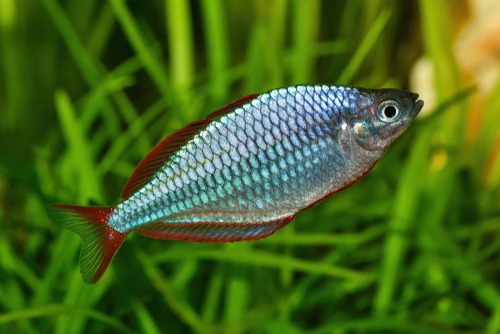
- Scientific Name: Melanotaenia praecox
- Size: 2 – 3.1 in
- Water Temperature: 75°F – 79°F
- Minimum Tank Size: 20-gallon – 6 fish
- Care: Moderate
- Compatible Species: Danios, Barbs, Dwarf Cichlids, Freshwater Gobies, Corydoras Catfish
- Origins: Mamberamo River in Western New Guinea
As you can probably tell by their name, these little fish glisten with every color of the rainbow when the light catches their iridescent bodies. They are relatively active and pretty hardy, and one of the smallest and least-expensive Rainbowfish that you can find.
Dwarf Neon Rainbowfish really stand out in a well-planted tank and they get on with other relatively peaceful species. It’s best to have a school of at least 6, with 1-2 females for every male to avoid conflict.
Pros
- Iridescent appearance
- Low-cost
- Active
Cons
- Males can fight if there are not enough females
- Require large tanks with a mix of open water and plantlife
11. Otocinclus Catfish (genus)
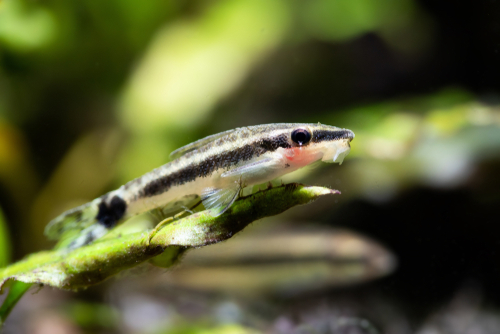
- Scientific Name: Otocinclus
- Size: 1 – 2 in
- Water Temperature: 72°F – 82°F
- Minimum Tank Size: 10-gallon – 1 individual
- Care: Easy
- Compatible Species: Mollies, Rasboras, Dwarf Gouramis, Corydoras Catfish, Boraras
- Origins: South America
This adorable genus of Catfish is a lot more varied than you might think. There are actually 22 different individual species of Otocinclus, but they are all around 2 inches in length and usually feature a horizontal stripe down the side of their bodies.
Otocinclus are peaceful and get along well with others, and they’re very popular due to the fact that they like to eat up the algae that grows in your tank.
Pros
- Varied colors
- Small size
- Eats algae
Cons
- Vulnerable to large, aggressive, or predator fish
- Can be shy and reclusive
12. Bristlenose Pleco
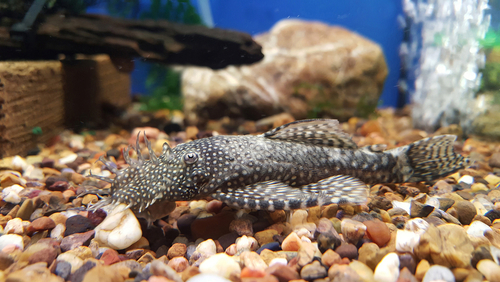
- Scientific Name: Ancistrus cirrhosus
- Adult Size: 4 – 5 in
- Water Temperature: 73°F – 81°F
- Minimum Tank Size: 20-gallon – 1/2 fish
- Care: Easy
- Compatible Species: Swordtails, Tetras, Platies, Guppies, Corydoras Catfish
- Origins: South America
If you want a fish that really stands out from the crowd, you won’t find many that are more distinctive than the Bristlenose Pleco. These remarkable suckerfish have a “bush” of bristly tentacles on their heads that almost look like an underwater beard.
They are a hardy species and they like to suction themselves onto rocks and decorations in the tank. Bristlenose Plecos are slightly larger than most of the other species that can live comfortably with Neon Tetras, but they are very docile and calm.
Pros
- Distinctive appearance
- Help to clean the tank
- Very calm
Cons
- Can be stationary for large parts of the day
- Need a larger tank
13. White Cloud Minnow
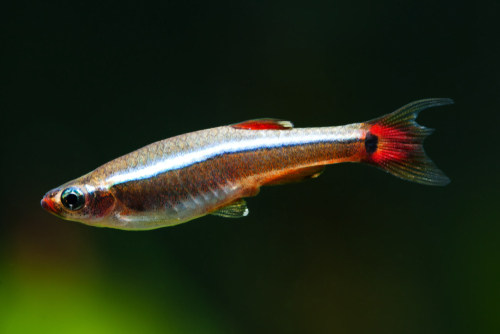
- Scientific Name: Tanichthys albonubes
- Size: 1 – 1.5 in
- Water Temperature: 64°F – 77°F
- Minimum Tank Size: 10-gallon – 5 fish
- Care: Easy
- Compatible Species: Gobies, Gouramis, Barbs, Danios, Loaches
- Origins: China and Vietnam
Perhaps a little less colorful than some of the other fish on our list, White Cloud Minnows are elegant and attractive, hailing from the mountain rovers of China and Vietnam.
They are known to be very easy to care for and peaceful outside of mating season, and they usually feel a lot more comfortable in a larger group.
Pros
- Easy to care for
- Hardy
- Tolerate a range of conditions
Cons
- Males can become aggressive during mating season
- Can jump out of a tank
14. Glass Catfish
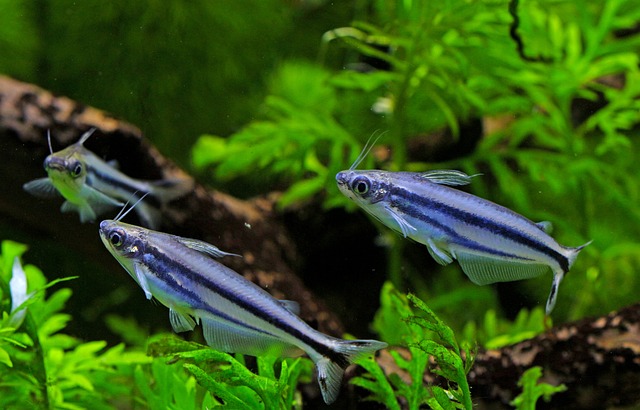
- Scientific Name: Kryptopterus vitreolus
- Size: 2.5 – 3.5 in
- Water Temperature: 75°F – 80°F
- Minimum Tank Size: 30-gallon tank for 5 fish
- Care: Moderate
- Compatible Species: Gouramis, Swordtails, Guppies, Mollies, Kuhli Loach
- Origins: Thailand
There are few fish that have a more intriguing appearance than the Glass Catfish. Their small bodies are entirely transparent, making them look almost ghostly and ethereal.
Glass Catfish are a little more tricky to care for than some of the other options on our list due to their particular water needs and the fact that they are happiest with a lot of room to move around.
Pros
- Incredible appearance
- More free-roaming than most Catfish
- Generally peaceful
Cons
- Vulnerable to changes in water conditions
- Have particular water needs
- Need larger tanks with more space
15. Kuhli Loach
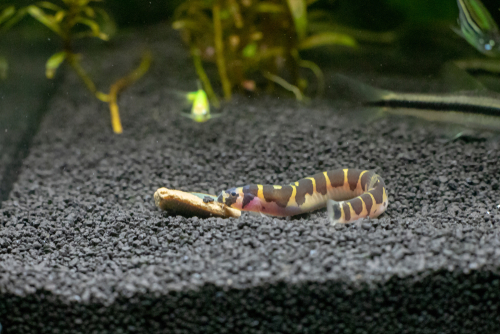
- Scientific Name: Pangio kuhlii
- Size: 2 – 4 in
- Water Temperature: 75°F – 86°F
- Minimum Tank Size: 35-gallon – 3 fish
- Care: Easy
- Compatible Species: Guppies, Dwarf Gouramis, Celestial Pearl Danios, Chili Rasbora
- Origins: Indonesia and the Malay Peninsula
Kuhli Loaches are a very easy-going member of the Loach family and look quite similar to the Java Loach, the Panda Kuhli, and the Black Kuhli. These particular fish, however, typically have yellow bodies shaped like an eel, and they’re covered in dark bands of black or brown.
They are very peaceful and non-aggressive, spending most of their time at the very bottom of your tank. They also like to burrow, and can seem to disappear for days at a time.
Pros
- Distinctive appearance
- Peaceful
- Low-maintenance
Cons
- Susceptible to skin diseases
- Inactive during the day
Conclusion
There are many different species of fish that can live happily in the same tank as Neon Tetras, but you still need to be careful with your selection.
Make sure that any tank mates for your Neon Tetras are relatively small, non-aggressive, and peaceful. They should have the same water parameter needs, and you definitely need to have enough room for everyone to have their own space.
Frequently Asked Questions
What big fish can live with neon tetras?
Most of the fish that make good tank mates for Neon Tetras are a similar size, but there are some highly docile and slightly larger fish that can live with them, such as Bristlenose Plecos.
How many neon tetras should be kept together?
You should always have at least six Neon Tetras in a group, otherwise, they can become stressed and aggressive towards one another. Around 8 to 12 fish in one group is usually when they are happiest.
How many neon tetras can I put in a 10 gallon tank?
A 10-gallon tank is about the minimum size that you should house Neon Tetras in, and you will have space for around 6 fish.

Ian Sterling, founder of Fishlab.com, began his aquarium journey over 30 years ago, driven by a deep fascination for fish and their diverse personalities. His website, Fishlab.com, is dedicated to making fishkeeping accessible and enjoyable, offering beginner-friendly guidance, expert insights, and a community for aquarists to connect and share experiences.


